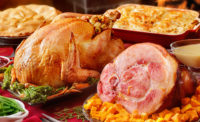Formulation Strategies
Experimenting with traditional proteins
The greater willingness by consumers to consider new meat and poultry options during the holidays creates expanded sales opportunities for retailers and suppliers.








Changing consumer dining preferences and attitudes along with shifting demographics are boosting the potential for larger and more diverse holiday sales for meat and poultry merchandisers.
While turkey remains the overwhelming choice for consumers at Thanksgiving, sales volumes are dropping and opening the door for the growth of additional protein options.
Turkey’s compounded annual growth rate (CAGR) from 2012 to 2016 was minus 1.2 percent, reports the Nielsen Co., a New York-based market research firm.
“Though traditional proteins still dominate, there is far more experimentation today with other meats during holiday meals than at any previous time,” says Maeve Webster, president of Menu Matters, an Arlington, Vt.-based foodservice consulting firm.
While a major factor in turkey’s decline is the advent of smaller households that require fewer portions, shopper interest in other selections is increasing, says Meagan Nelson, associate director with Nielsen Fresh Growth and Strategy, a Chicago-based fresh foods research and consulting firm.
Whereas 78 percent of annual whole-turkey sales occur in November, only 20 percent of households ever purchase a whole turkey, she says.
“It is important to focus on that other 80 percent of households because consumers still have 19 to 20 other meals to deal with during the Thanksgiving and Christmas weeks,” she says. “There is so much more opportunity for retailers.”
Whole turkeys, ham and ground beef are the top three Thanksgiving proteins, while the order changes at Christmas with ham, ground beef and whole turkeys most popular, Nelson says, with each of the top Christmas proteins having a CAGR of 6 percent to 7 percent from 2012 to 2016.
During Thanksgiving, the CAGR was about 4 percent for ham and 1.2 percent for ground beef, she says.
Chicken thighs also are becoming more popular during the holidays with a 6.3 percent CAGR from 2012 to 2016 during Thanksgiving week and a 12.7 percent CAGR at Christmas, Nelson says, adding that the dark meat in chicken thighs is particularly attractive to Asian and Hispanic shoppers.
In search of a new tradition
“There are consumers who may be tired of turkey or whatever is their traditional holiday meal,” she says. “Retailers can excite them by offering additional protein options with different flavor profiles, which also creates opportunities for value added products.”
Such selections can include items that simplify meal preparation, such as preseasoned meats and poultry, she says.
Nielsen sales data from 2016 reveals that a wide range of fresh meat and poultry were selling significantly above average for the first three weeks of November compared with an average week of the year, reports Anne-Marie Roerink, principal of 210 Analytics LLC, a San Antonio-based marketing research and strategies firm.
In addition to the different turkey varieties — whole turkeys, value-added whole turkeys, value-added turkey breasts, value-added turkey drumsticks/legs, turkey roasts and boneless breasts — the list of hotter selling items includes duck, geese, ham/leg, value-added lamb roasts, value-added lamb ribs and Cornish hens, she says.
Selling significantly greater during the four weeks of December were pork ham/leg, geese, pheasant, duck, squab, value-added lamb roasts, value-added lamb ribs, value-added veal ribs and leg of lamb, Roerink says.
"Traditional holiday flavors will still play a major role going forward, but consumers in general are open to trying a lot more flavors than in the past.”
— Maia Chang, Technomic Inc.
“Many cuts have huge seasonal spikes and some are good or strong everyday sales candidates to promote during holidays to offer shoppers variety and take meal occasions from restaurants by offering restaurant quality holiday solutions,” she says.
A slide to the sides
Incorporating different proteins into side dishes is another avenue for driving greater holiday meat and poultry sales, Webster notes. Shopper interest in side dishes already is expanding as more foodservice outlets expand their range of options to compensate for a reduction in entree selections, she says, adding that holiday meals traditionally feature more side dishes than other eating occasions throughout the year.
Additional holiday protein sales opportunities include merchandising meal kits, which enable convenience-minded shoppers to purchase packages that contain all the meal ingredients. A 2016 Nielsen survey found that 16 percent of consumers would prefer to create their Thanksgiving meal from a kit, Nelson says, noting the concept is especially popular with younger shoppers.
The survey found 28 percent of consumers between the ages of 18 and 34 say they would rather use a meal kit, along with 23 percent of people between 35 and 44.
“Younger consumers don’t cook as much as older generations and thus will look to supermarkets for help in preparing holiday meals,” says Maia Chang, senior research analyst, consumer insights, for Technomic Inc., a Chicago-based food industry research and consulting firm. “Solutions can include using meal kits or purchasing prepared foods from the deli section.”
Millennials, most of whom are in their 20s and 30s, are more culturally diverse than many other demographic groups and will be a key catalyst for changes in holiday eating behavior, Nelson states.
“They are just coming into their spending power, and many of the consumers still want the comfort of the traditional meal but with a twist, such as adding global spices to make the meal unique,” she says.
Retailers, meanwhile, can potentially trigger supplementary sales by responding to the unique behaviors of their various shopper segments, Webster says. For example, Millennials who live in urban areas typically will seek different options than rural Millennials.
In addition, while some consumers prefer making meals from scratch and will look to retailers for recommendations, others want prepared options. This should lead to merchandising appropriate selections in delis and other store sections, she says.
“Retailers and suppliers must first understand the recent behavior of shoppers and a store’s customer mix and take it from there,” Webster says. “During the holidays, for instance, analysis shows there is less demand for preseasoned and preflavored meat pieces and more for preseasoned whole turkeys. People also are becoming more receptive to different types of proteins and less traditional holiday options.”
Follow foodservice footsteps
Restaurants also influence holiday buying behavior as many shoppers, after experiencing new flavors and proteins on menus, seek to replicate the tastes in their home-prepared meals, Chang says. “Traditional holiday flavors will still play a major role going forward, but consumers in general are open to trying a lot more flavors than in the past,” she says.
The gradual acceptance of nontraditional protein recipes is in part from the changing ethnic backgrounds of Americans along with the growing base of Millennial shoppers who are receptive to newer alternatives, such as a Christmas spread of Indian food, she says.
Even turkey is being prepared in newer ways, with consumers adding different brines, glazes and sauces to enhance the flavor, Chang says.
A major challenge for retailers is determining the optimal prepared holiday meal offerings to merchandise in each store location, Webster says. Among the options is to merchandise items in accordance with the ethnic traditions of shoppers, she says.
“There won’t be one solution for every retailer,” Webster says. “Retailers have to evaluate their location, the potential interests of their regular customer bases and determine if they are achieving more sales with prepared or off-the-shelf options. All of that will impact how they go to market with holiday selections.”
In addition, retailers face the task of adopting the mindset of promoting different protein options in addition to turkey, Nelson adds.
“The November to December time frame is such a critical period for food sales, so it is vital that retailers get their promotional strategies right,” she says. NP
Looking for a reprint of this article?
From high-res PDFs to custom plaques, order your copy today!









